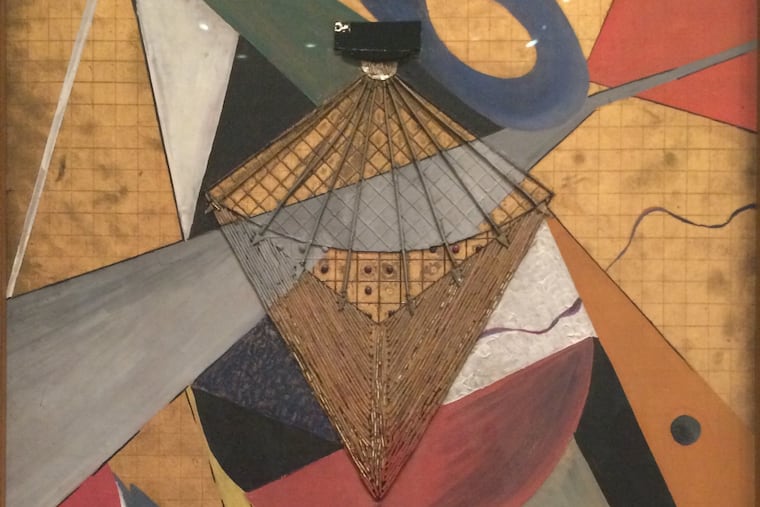These other Duchamp siblings are something to see at the Philadelphia Museum of Art
Two other gallery shows of note this month: Edward McHugh at Works on Paper and a requiem for Philly real estate at Brooke Lanier Fine Art.

There’s a fascinating, under-the-radar exhibition in the Anne d’Harnoncourt Gallery at the Philadelphia Museum of Art that I’m urging you to see before it closes on Aug. 11.
“Duchamp Family” offers a rare opportunity to see works by Marcel Duchamp, along with those by his brothers Gaston and Raymond, his sister, Suzanne, and Suzanne’s husband, Jean Crotti, a Swiss-born painter. It has been occupying the d’Harnoncourt Gallery space while much of the museum’s Marcel Duchamp collection has been out traveling — to Tokyo, Seoul, and Sydney.
This small survey takes over the gallery so seamlessly, it’s easy to forget what’s missing. Comfortingly, some of Marcel Duchamp’s iconic works have stayed put in the spots they’ve always occupied, including his last major work, Etant donnés, the curious tableau viewed through peepholes in a wooden door. The Bride Stripped Bare By Her Bachelors, Even (also known as The Large Glass) is here, too.
Marcel, who left France for New York, was of course the family’s star, taken up by collectors (among them Walter and Louise Arensberg, who gave all those Duchamps to the Philadelphia Museum of Art). But his siblings are also known for their contributions to modern art.
Marcel felt that Gaston, the eldest, had the greatest ability as a draftsman. That’s borne out by a seemingly effortless 1904 ink drawing of Marcel and Suzanne, and a 1912 etching in a Cubist style of Suzanne. Gaston, who would go on to change his name to Jacques Villon, was also an accomplished painter, as seen in a geometric composition here.
Raymond Duchamp was a sculptor who went by the surname Duchamp-Villon. He’s represented here by a 1907 terra-cotta bust reminiscent of Gauguin’s Tahitian work, a 1911 plaster bust with a distinctly Art Deco look, and a meticulously modeled 1914 plaster maquette for an architectural project. There’s also a group of plaster sculptures that shows him flirting with abstraction.
After studying at the Ecole des Beaux-Arts in Rouen and painting family gatherings in a Post-Impressionist style, Suzanne Duchamp began experimenting in Analytic Cubism. After marrying Crotti, she started incorporating machine imagery and industrial materials into her paintings, as seen here in her “Radiation of Two Solitary Beings Apart” (1916-1920), which includes glass, plastic, and tin foil among its components.
Crotti is represented by “Squared Composition” (1916), a painting on glass incorporating beads, sequins, and lead wire. A photograph of a whimsical wire bust he made — with artificial eyeballs! — is here, too. The sculpture had been a portrait of Marcel Duchamp and mysteriously disappeared after it was photographed in 1916.
The only family artist missing from this otherwise excellent show is the Duchamp siblings’ maternal grandfather, Emile Frédéric Nicolle, a prominent printmaker in 19th-century France. He was known for his engravings of medieval Rouen, which were displayed in the Duchamp family home and would certainly have made an impression on his grandchildren.
Through Aug. 11 at the Philadelphia Museum of Art, 2600 Benjamin Franklin Parkway. 10 a.m. to 5 p.m. Sunday, Tuesday, Thursday, and Saturday; 10 a.m. to 8:45 p.m. Wednesday and Friday. 215-763-8100 or philamuseum.org.
Small works from a big name
Philadelphia-based artist Edward McHugh is the painter behind the outdoor and indoor wall panels at the Harper Residences, a new Philadelphia apartment building on 19th Street between Chestnut and Sansom Streets.
McHugh also has a show at the nearby Works on Paper gallery of smaller paintings with similarly drippy expanses of beautiful color, in this case hemmed in by borders of matte black. Maybe that’s his point.
Through Aug. 15 at Works on Paper, 1611 Walnut St., 11 a.m. to 5 p.m. Tuesday through Saturday. 215-988-9999 or worksonpaper.biz.
A requiem for real estate
“The Poetics of Decay” at Brooke Lanier Fine Art gathers works by five artists who capture the history of Philadelphia buildings and neighborhoods — and their imminent demise amid the ongoing real estate boom.
Jennifer Manzella’s small etchings of the city’s disappearing buildings and properties are particularly poignant. Dolores Poacelli’s Wall/Steps is a like a bar graph of overdevelopment.
Through Aug. 30 at Brooke Lanier Fine Art, 820 S. 4th St., noon to 6 p.m. Tuesday and Thursday, 11 a.m. to 5 p.m. Friday, 11 a.m. to 3 p.m. Saturday. 267-329-9653 or brookelanier.com.